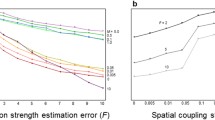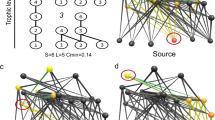Abstract
Food chain models have dominated empirical studies of trophic interactions in the past decades, and have lead to important insights into the factors that control ecological communities. Despite the importance of food chain models in instigating ecological investigations, many empirical studies still show a strong deviation from the dynamics that food chain models predict. We present a theoretical framework that explains some of the discrepancies by showing that trophic interactions are likely to be strongly influenced by the spatial configuration of consumers and their resources. Differences in the spatial scale at which consumers and their resources function lead to uncoupling of the population dynamics of the interacting species, and may explain overexploitation and depletion of resource populations. We discuss how changed land use, likely the most prominent future stress on natural systems, may affect food web dynamics by interfering with the scale of interaction between consumers and their resource.



Similar content being viewed by others
References
Bardgett RD, Wardle DA. 2003. Herbivore mediated linkages between aboveground and belowground communities. Ecology 84:2258–68
Carpenter SR, Kitchell JF, Hodgson JR. 1985. Cascading trophic interactions and lake productivity. Bioscience 35:634–9
Chase JM. 2000. Are there real differences among aquatic and terrestrial food webs? Trends Ecol Evol 15:408–12
De Roos AM, McCauley E, Wilson WG. 1998. Pattern formation and the spatial scale of interaction between predators and their prey. Theor Popul Biol 53:108–30
Grover JP. 2003. The impact of variable stoichiometry on predator–prey interactions: a multinutrient approach. Am Nat 162:29–43
Hairston NG, Smith FE, Slobodkin LB. 1960. Community structure, population control, and competition. Am Nat 94:425
Hassell MP, Comins HN, May RM. 1991. Spatial structure and chaos in insect population-dynamics. Nature 353:255–8
Hassell MP, Comins HN, May RM. 1994. Species coexistence and self-organizing spatial dynamics. Nature 370:290–292
Holt RD. 1977. Predation, apparent competition, and the structure of prey communities. Theor Popul Biol 12:197–229
Holt RD. 1997. Community modules. In: A.C. Gange and V.K. Brown, Eds. Multitrophic Interactions in Terrestrial Ecosystem, 36th Symposium of the British Ecology Society. Blackwell Science. p. 333–349
Holt RD. 2002. Food webs in space: on the interplay of dynamic instability and spatial processes. Ecol Res 17:261–273
Holt RD, Lawton JH. 1993. apparent competition and enemy-free space in insect host–parasitoid communities. Am Nat 142:623–45
Huxel GR, McCann K. 1998. Food web stability: the influence of trophic flows across habitats. Am Nat 152:460–9
Jefferies RL. 2000. Allochthonous inputs: integrating population changes and foodweb dynamics. Trends Ecol Evol 15:19–22
Juska A, Busch L, Tanaka K. 1997. The blackleg epidemic in Canadian rapeseed as a “normal agricultural accident”. Ecol Appl 7:1350–6
Kitching RL. 2001. Food webs in phytotelmata: “Bottom-up” and “top-down” explanations for community structure. Annu Rev of Entomol 46:729–60
Loladze I, Kuang Y, Elser JJ. 2000. Stoichiometry in producer-grazer systems: linking energy flow with element cycling. Bull Math Biol 62:1137–62
Madsen J, Bregnballe T, Hastrup A. 1992. Impact of the Arctic fox Alopex-Lagopus on nesting success of geese in Southeast Svalbard, 1989. Polar Res 11:35–39
McCann KS, Hastings A, Huxel GR. 1998. Weak trophic interactions and the balance of nature. Nature 395:794–8
Milne BT. 1992. Spatial aggregation and neutral models in fractal landscapes. Am Nat 139:32–57
Oksanen L, Fretwell SD, Arruda J, Niemela P. 1981. Exploitation ecosystems in gradients of primary productivity. Am Nat 118:240–61
Orrock JL, Danielson BJ, Burns MJ, Levey DJ. 2003. Spatial ecology of predator–prey interactions: corridors and patch shape influence seed predation. Ecology 84:2589–99
Ostman O, Ekbom B, Bengtsson J, Weibull AC. 2001. Landscape complexity and farming practice influence the condition of polyphagous carabid beetles. Ecol Appl 11:480–8
Pace ML, Cole JJ, Carpenter SR, Kitchell JF. 1999. Trophic cascades revealed in diverse ecosystems. Trends Ecol and Evol 14:483–8
Persson L. 1999. Trophic cascades: abiding heterogeneity and the trophic level concept at the end of the road. Oikos 85:385–97
Polis GA. 1999. Why are parts of the world green? Multiple factors control productivity and the distribution of biomass. Oikos 86:3–15
Polis GA, Hurd SD. 1995. Extraordinarily high spider densities on islands – flow of energy from the marine to terrestrial food webs and the absence of predation. Proceedings of the National Academy of Sciences of the United States of America 92:4382–6
Polis GA, Sears ALW, Huxel GR, Strong DR, Maron J. 2000. When is a trophic cascade a trophic cascade? Trends Ecol Evol 15:473–5
Power ME. 1992. Top-down and bottom-up forces in food webs – do plants have primacy. Ecology 73:733–6
Ritchie ME, Olff H. 1999. Spatial scaling laws yield a synthetic theory of biodiversity. Nature 400:557–60
Sanchez-Pinero F, Polis GA. 2000. Bottom-up dynamics of allochthonous input: direct and indirect effects of seabirds on islands. Ecology 81:3117–32
Schmitz OJ, Hamback PA, Beckerman AP. 2000. Trophic cascades in terrestrial systems: a review of the effects of carnivore removals on plants. Am Nat 155:141–53
Strong DR. 1992. Are trophic cascades all wet – differentiation and donor-control in speciose ecosystems. Ecology 73:747–54.
Van de Koppel J, Rietkerk M. 2004. Spatial interactions and resilience in arid ecosystems. Am Nat 163:113–121
Van de Koppel J, Rietkerk M, van Langevelde F, Kumar L, Klausmeier CA, Fryxell JM, Hearne JW, van Andel J, de Ridder N, Skidmore A, Stroosnijder L, Prins HHT. 2002. Spatial heterogeneity and irreversible vegetation change in semiarid grazing systems. Am Nat 159:209–218
Vitousek PM, Mooney HA, Lubchenco J, Melillo JM. 1997. Human domination of Earth’s ecosystems. Science 277:494–9
Wallisdevries MF. 1996. Nutritional limitations of free-ranging cattle: the importance of habitat quality. J Appl Ecol 33:688–702
Wallisdevries MF, Laca EA, Demment MW. 1999. The importance of scale of patchiness for selectivity in grazing herbivores. Oecologia 121:355–63
Yodzis P. 1989. Introduction to theoretical ecology. Harper & Row, New York, USA
Acknowledgements
We thank Martijn Bezemer, Jeff Harvey, Wim van der Putten, Peter de Ruiter, and two anonymous reviewers for constructive comments and suggestions. This paper results from a exploratory ESF workshop on “Trophic Interactions in a Changing World”, at Texel, The Netherlands (2002). The research of M.R. is supported by a grant from the Research Council Earth and Life Sciences of the Netherlands Organization of Scientific Research (NWO-ALW). This is contribution 3334 of the Netherlands Institute of Ecology.
Author information
Authors and Affiliations
Corresponding author
Rights and permissions
About this article
Cite this article
Van de Koppel, J., Bardgett, R.D., Bengtsson, J. et al. The Effects of Spatial Scale on Trophic Interactions. Ecosystems 8, 801–807 (2005). https://doi.org/10.1007/s10021-005-0134-2
Received:
Accepted:
Published:
Issue Date:
DOI: https://doi.org/10.1007/s10021-005-0134-2




